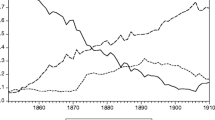Summary
During the early eighties the liquidity ratio in The Netherlands shows a sharp rise. The aim of this article is to inquire into the causes of this rise. This has been done by means of the demand theory of money. The analysis leads to the following conclusions.
-
(1)
An aggregate analysis of money demand does not seem appropriate.
-
(2)
Disaggregation of money demand into household and business demand yields more satisfactory results:
-
(a)
money demand by business depends on the real value added of the business sector, the GNP deflator and labour's share in the value added of the business sector;
-
(b)
money demand by households depends on real gross national product, the GNP deflator and the capital market interest rate.
-
(3)
The rise in the early eighties is essentially due to the increase in the money holdings of the business sector, which in turn is mainly caused by the increase in profitability.
Similar content being viewed by others
Author information
Authors and Affiliations
Additional information
The authors are indebted to Mr. E. Sterken for his suggestions with respect to the allocation of the money stock to the household and the business sector, to Mr.A.R.M. Gigengack and Professor J. Pen for improving the English and the readibility of the paper and to Professor A.H.E.M. Wellink for his penetrating comments on an earlier draft of the paper.
Rights and permissions
About this article
Cite this article
Kuipers, S.K., Boertje, B. On the causes of the rise in the liquidity ratio in The Netherlands during the early eighties. De Economist 136, 50–90 (1988). https://doi.org/10.1007/BF02078539
Issue Date:
DOI: https://doi.org/10.1007/BF02078539




